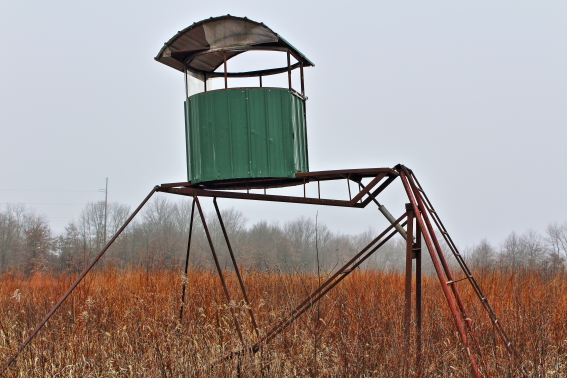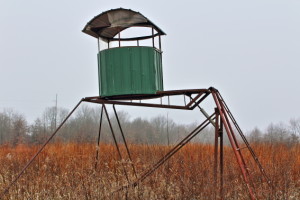Just because deer season is pretty much over in a majority of the country doesn’t mean it’s time to stop thinking about it. Now’s the time to take some of your most important steps towards success for next season. Our number one rule is to reduce human pressure in your area during deer season and the months leading up to it. So now is the time to complete your next steps.
One of those necessary steps is identifying where to put a new deer stand or where to move an existing one. Hopefully you kept notes about your observations of deer movement throughout this past season. Maybe you’ve even used the snowfall to identify some new major travel routes you hadn’t taken advantage of before. Regardless, now is the time to put that new found knowledge to use by putting up your deer stand over those new hot spots.
The video below showcases a few deer stand location tips for you to follow as you start the process of identifying your next stand location. Make sure you watch in HD!
There are a few major things to look for when placing a tree stand:
1. Size of the tree – you want to make sure you find the biggest tree possible in diameter to hang your deer stand on. This will help break up the outline of your stand, as well as yourself. If you hunt a real windy day, the bigger tree will also help prevent a lot less swaying in the wind than a smaller tree would. This can be a really scary experience and if the wind is quite strong, I recommend you forego sitting in a tree altogether.
2. Height – one of the major keys for evading a deer’s detection is staying out of their line of sight. If possible, you want to use deer stands that will be at least 20 feet or taller. This will reduce the chance of them catching your movement. Just make sure to be safe by always wearing a safety harness that fits you well.
3. Natural travel corridors – look for natural funnels, like a tree line that runs along a food plot. If you have a creek or a river, those are great places for wildlife to travel along. Don’t be surprised if you see a deer swim right across the water either. They are excellent swimmers! If you can locate a travel route between a known bedding area and a major food source, you might have just found your next big buck kill zone. Just make sure that you keep your stand anywhere from 15-30 yards off any major trail that you find. You never want to be set up right on top of it.
Some things you want to avoid with your next deer stand placement:
1. Setting up in the wide open – if you can avoid it, keeping your deer stands out of the wide open is very important. You want to make sure your human outline is broken up as much as possible and that your set up will allow you to hide as much of your movement as possible. In the case below, this stand was only about 10 feet off the ground and was in the wide open. Because of the stand’s design and it’s location in the middle of the field, deer can see any hunter sitting in it very easily because they are silhouetted against the sky. Getting a shot off on a deer within 100 yards is sheer luck in this set up.
Click photos to enlarge.
Above: This stand location is very poor because it is in the wide open and isn’t very tall. Deer can see right through it because there is nothing to break up a hunter’s outline from the sky.
Above: A farther shot shows just how much the stand is in the wide open. The location could be improved by moving it back about 20 yards to border the trees. It could also be improved by adding some kind of curtain system so the hunter’s outline could be broken up even more.
2. Placing tree stands on a skinny tree – this is an absolute no no for several reasons. It doesn’t sufficiently break up the outline of your deer stand or you, which makes you look like an unnatural extension of the tree. You will become the center of attention from just about any form of wildlife in this set up. Additionally, I consider skinnier trees to be less safe. They sway much more in the wind, leaving more opportunity for you to lose your balance. It could cause you to miss a shot on an animal or fall out of the stand completely.
3. Setting up right on a trail – while this might sound good in theory, it actually presents several problems. For one, you are likely to be right on top of the deer as they come by, which leaves you more vulnerable to being detected. Additionally, it also prevents you from having many good shot opportunities as the deer are likely coming straight at you or straight from behind you. If you set up 15-30 yards away, you avoid the chance of detection more and also set yourself up for more doable, broadside shots.
4. Waiting until September to put new stands up – the number one facet of the Elite Hunter series to kill more mature bucks is to reduce human pressure in your hunting area. That is especially important during deer season and the months leading up to it. Make sure you get your stands placed and shooting lanes cut between now and early summer if at all possible. This will allow you to stay out of your hunting area and will let the deer relax and feel comfortable in your favorite spots. When your neighbors start wreaking havoc in the fall with their vehicles and shots, the deer will flee to where they feel comfortable and safe. That means good things for you.
If you have any further questions about this topic or others, please leave a comment and we’ll make sure to answer them! If you’d like to get our opinion on one of your stand locations and how you could improve it, comment with a picture or send us an email through our Contact Us page!




